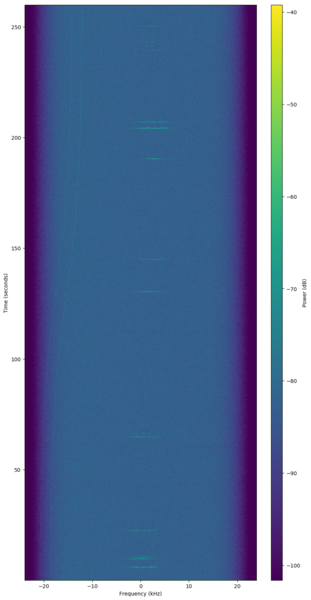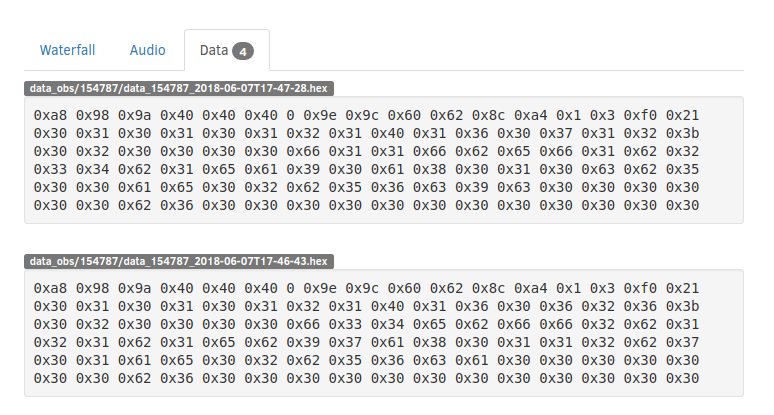Difference between revisions of "AFSK"
(AFSK waterfall) |
|||
| (2 intermediate revisions by 2 users not shown) | |||
| Line 1: | Line 1: | ||
| + | == Introduction == | ||
| + | AFSK is an acronym for Audio frequency-shift keying. | ||
| + | AFSK is a modulation technique by which digital data is represented by changes in the frequency (pitch) of an audio tone, yielding an encoded signal suitable for transmission via radio or telephone. Normally, the transmitted audio alternates between two tones: one, the "mark", represents a binary one; the other, the "space", represents a binary zero. | ||
| + | |||
| + | AFSK differs from regular frequency-shift keying in performing the modulation at baseband frequencies. In radio applications, the AFSK-modulated signal normally is being used to modulate an RF carrier (using a conventional technique, such as AM or FM) for transmission. | ||
| + | |||
| + | == Waterfalls == | ||
| + | Example waterfalls below: | ||
| + | |||
| + | <gallery mode="packed" widths=310px heights=400px> | ||
| + | File:Waterfall_1439401_2019-12-26T17-19-27.png|[[AFSK1k2]] | ||
| + | </gallery> | ||
| + | |||
| + | == SatNOGS Demodulator == | ||
SatNOGS has a built-in demodulator for AFSK (Audio Frequency Shift Keying). Here's what a typical AFSK demod looks like. The (4) on the data tab shows that there are four demods available. Only two are shown here. | SatNOGS has a built-in demodulator for AFSK (Audio Frequency Shift Keying). Here's what a typical AFSK demod looks like. The (4) on the data tab shows that there are four demods available. Only two are shown here. | ||
<p>[[File:SatNOGS AFSK.png]]</p> | <p>[[File:SatNOGS AFSK.png]]</p> | ||
| + | |||
| + | == See also == | ||
| + | * [https://en.wikipedia.org/wiki/Frequency-shift_keying#Audio_FSK Wikipedia Audio FSK] | ||
| + | |||
| + | [[Category:RF Modes]] | ||
Latest revision as of 23:10, 14 January 2020
Introduction
AFSK is an acronym for Audio frequency-shift keying. AFSK is a modulation technique by which digital data is represented by changes in the frequency (pitch) of an audio tone, yielding an encoded signal suitable for transmission via radio or telephone. Normally, the transmitted audio alternates between two tones: one, the "mark", represents a binary one; the other, the "space", represents a binary zero.
AFSK differs from regular frequency-shift keying in performing the modulation at baseband frequencies. In radio applications, the AFSK-modulated signal normally is being used to modulate an RF carrier (using a conventional technique, such as AM or FM) for transmission.
Waterfalls
Example waterfalls below:
SatNOGS Demodulator
SatNOGS has a built-in demodulator for AFSK (Audio Frequency Shift Keying). Here's what a typical AFSK demod looks like. The (4) on the data tab shows that there are four demods available. Only two are shown here.

